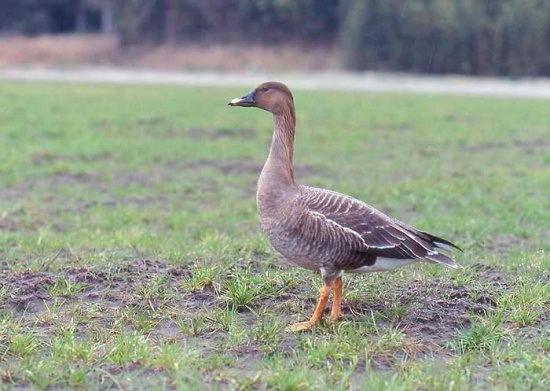- Anser serrirostris
Identification
Length 66–75 cm, weight (A. s. rossicus) 1,970-3,300 g
- Dark goose with a long neck
- Head, neck, and back are dark brownish
- Lightest on the back
- Underside is lighter
- Legs bright 'dayglo' orange
- Bill is short (not much longer than it is high)
- Birds with more than a small orange spot near the tip of the bill are rare
- Orange is always sharply defined (mostly more diffusely edged in Taiga Bean Goose)
In flight, tail pattern is conspicuous: narrow white terminal band, broader black band, and the innermost part white. Belly is white. Both upper and lower sides of wings are dark, without much contrast between coverts and primaries/secondaries.
Juvenile forms are more scaly on the back and lack the white at the base of the bill.
Similar species
Taiga Bean Goose is very similar in plumage but is larger and has a longer neck, a longer bill and usually more orange on the bill. Pink-footed Goose is very similar in size and structure, but is a paler, more silvery grey on the back, and with pink legs and bill markings; it also has conspicuous silvery grey forewing in flight, and a broader white tip to the tail.
Distribution
Breeds on the tundra of northern Russia including Siberia.
Winters in eastern Asia (China, Japan, Korea) and northern Europe (primarily Hungary, northen Germany, and the Netherlands, with smaller numbers in many other countries); generally further south than Taiga Bean Goose. Abundant in suitable areas, with around 300,000 wintering in northern Europe, including 30,000 in the Netherlands. In Britain, a scarce winter visitor to the east coast from southeast Scotland south to Suffolk, typically as individuals or small groups in flocks of Pink-footed Geese or White-fronted Geese.
Taxonomy
Two subspecies are accepted[1]:
- A. s. serrirostris: tundra zone in eastern Siberia
- Larger, and with a longer bill (structurally between Pink-footed Goose and Taiga Bean Goose)
- Smaller, and with a shorter bill (structurally very similar to Pink-footed Goose)
Has long been considered conspecific with Taiga Bean Goose and named Bean Goose Anser fabalis. In the more distant past, Pink-footed Goose was also sometimes included in Bean Goose.
Habitat
Breeds by arctic tundra pools. Winters in agricultural areas, mostly grassy fields.
Behaviour
Diet
In winter, it grazes in crops such as grass, cereals and potatoes.
Vocalisation
References
- Clements, JF. 2009. The Clements Checklist of Birds of the World. 6th ed., with updates to December 2009. Ithaca: Cornell Univ. Press. ISBN 978-0801445019.
- Birdforum thread discussing the taxonomy of the Bean Goose complex.
External Links
GSearch checked for 2020 platform.1






